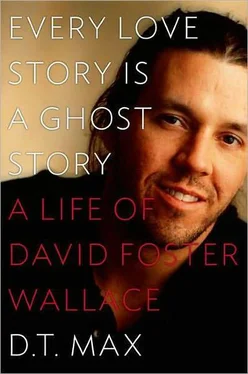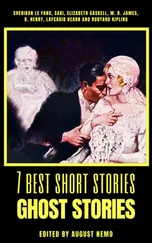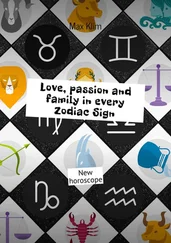Wallace went to a doctor who told him he needed to quit drinking and go to a rehab facility. But Wallace was worried that Harvard would fail him if he took a month off. In late October he forced the issue. He called Costello from the Harvard Health Services and said that he had told the school he was thinking of hurting himself. Once you did that, he explained, the university had no choice but to put you on suicide watch. He asked Costello to bring his bathrobe, his cigarettes, his notebook, and a small TV and meet him at McLean Hospital, the psychiatric institute in Belmont affiliated with the university. “The lovely medical staff at Harvard is putting me in an alcohol rehab and detox center on 11/2,” he wrote Brad Morrow. “Apparently I have liver problems. No joy in mudville.”
CHAPTER 5. “Please Don’t Give Up on Me”
The four weeks Wallace spent at McLean in November 1989 changed his life. This was not his first or most serious crisis, but he felt now as if he had hit a new bottom or a different kind of bottom. For all that he had thought of “Westward” as an “Armageddon,” as he would later tell an interviewer, he had really expected it to be a phoenix. From the ashes to which he had reduced postmodernism a new sort of fiction was meant to arise, as laid out in “Fictional Futures and the Conspicuously Young.” How else to understand the love note to the reader at the end of “Westward”? But instead of rebirth, a prolonged dying had followed, and for the past year the corpse had moldered. Wallace hadn’t even been able to finish a nonfiction piece without help since 1987. Never before had he worked so hard with so little to show for it.
Wallace was placed in Appleton House. Outside, the building was attractive — colonial revival à la Harvard. Inside it had the look of a faded country hotel, with tattered wine-colored carpets, old brass lamps, and a deep smell of tobacco. Appleton was where the addicts went, with a large room for substance abuse recovery meetings. The medical staff interviewed the twenty-seven-year-old Wallace and told him that he was a hard-core alcohol and drug user and that if he didn’t stop abusing both he would be dead by thirty. Wallace in turn reported the news to Costello, who came the next day. “I’m a depressive, and guess what?” Wallace said. “Alcohol is a depressant!” He smiled through his tears, as if, Costello remembers, he “was unveiling a fun surprise to a five-year-old.” It was of course information Wallace knew already.
The program was meant to shake up the addict, and, with Wallace, it succeeded. Pulling him out of his old life and keeping him away from its temptations and habits helped. In the end, though, what mattered most was probably that the intoxicated Wallace was no longer writing successfully, which left open the hope that a sober one might. Wallace saw a therapist and went to substance abuse meetings every day. He detoxed from the alcohol. Nadell, back in the Northeast to be with her family for Thanksgiving, came by to see her author a few weeks after his admission. Wallace was already calmer by then. He met them in a brightly lit room full of other patients, all smoking and drinking black coffee and meeting with friends and family. Wallace looked so ragged that Nadell borrowed a pair of scissors from the staff and cut his hair. But she was happy to see he was writing in a notebook. His doctors gave Wallace a pass, and he and his friends walked in the woods at the foot of the campuslike property. McLean was the storied holding tank for many literary depressives, from Sylvia Plath to Robert Lowell, and it occurred to Wallace’s friends that this gave him at least some comfort, that he thought of himself as at a mental health Yaddo. Wallace’s cheerfulness, Nadell felt, kept breaking out.
It was Wallace’s expectation that he would go back to Harvard after his stay at McLean. He was, after all, still enrolled in the graduate program. But the psychiatric staff kept advising him against it. They told him that without continuing support he would just go back to his old habits. Returning to Somerville would be a catalyst for that mistake. Wallace was at first resistant — he did not recognize himself in their phrase “hard-core recidivist,” but as the weeks went by he felt farther and farther away from his old self and must have begun, amid his anxiety about writing, to concede the point that survival had to come first. In any event, he chose to go to a halfway house in Brighton run by a woman who had worked in a psychology lab funded by NASA before she herself went into rehab. He hoped she would understand what he saw as the particular problems of a person as intelligent and educated as himself and provide support. It would be the next best thing to McLean, which Wallace was — Costello noted — sorry to have to leave. He had gotten used to the routines — the meetings, the therapy, the order, the prepared meals — not entirely unlike home. Brighton was a world away from Cambridge, and he did not know what to expect. Despite having written a book on rap, his knowledge of anything other than middle-class academic life was minimal. He wrote Nadell at the end of November, “I am getting booted out of here and transferred to a halfway house…. It is a grim place, and I am grimly resolved to go there.”
Granada House was on the grounds of the Brighton Marine hospital near the Massachusetts Turnpike. 1Wallace gives a good picture of its fictional counterpart in Infinite Jest , the novel it would help inspire:
Unit #6, right up against the ravine on the end of the rutted road’s east side, is Ennet House Drug and Alcohol Recovery House, three stories of whitewashed New England brick with the brick showing in patches through the whitewash, a mansard roof that sheds green shingles, a scabrous fire escape at each upper window and a back door no resident is allowed to use and a front office around on the south side with huge protruding bay windows that yield a view of ravine-weeds and the unpleasant stretch of Commonwealth Ave.
The compound consisted of seven buildings—“seven moons orbiting a dead planet,” as it is described in Infinite Jest —all leased to various substance abuse and mental health assistance groups. Wallace met Deb Larson, the director, at his new temporary home. Tall and blonde, she walked with a limp: drunk, she had fallen down in her kitchen, hitting her head, causing a partial paralysis. Even then she hadn’t stopped drinking. Wallace respected her. She was pretty and smart and gave him a link to an old life that was still his present — you could almost see Harvard from the top floor of the building. 2Recovery facilities tried to control the stress levels of their participants, and one activity they generally prohibited was school. Wallace had no choice but to call the philosophy department at Harvard and ask for a leave of absence. He was too humiliated to go back to get the vegetable juicer, a gift from his mother, that he had left behind in the graduate office.
As a new arrival, Wallace was not allowed out of the building on his own for the first ten days. For the next twenty he could go out only to substance abuse meetings. Then he was expected to find low-level work. Wallace, whose only real skill was teaching and writing, cast around and was able — probably thanks to the presence on his résumé of the head of Amherst College security as a reference — to get hired as a guard at Lotus Development, a large software company. Granada House rules stipulated a forty-hour workweek, so Wallace got up at 4:30 in the morning to take the Green Line subway and worked until 2 p.m., walking a vast disk packaging plant in Lechmere, clocking in his whereabouts every ten minutes and twirling his baton (or so he later said). He would tear pages out of his notebook and send letters to his friends, maintaining contact with the small group of editors and writers who were vital to him. The Lotus experience, he recalled in a later interview, reminded him of “every bad ’60s novel about meaningless authority,” but at the time he bore it well. “Give me a little time to get used to no recreational materials and wearing a polyester uniform and living with 4 tatooed ex-cons and I’ll be right as rain,” he wrote Moore with ironic brio shortly after starting. Even inside Granada House, he managed to attend to the business of being a writer — following up on submissions to magazines and reading pages of stories he had coming out. He could see the strange side of his situation. When the galleys of “Order and Flux in Northampton” arrived from Conjunctions with a page missing, he told Morrow he could send it at his convenience. “I’m not going anywhere for Xmas,” he wrote.
Читать дальше












